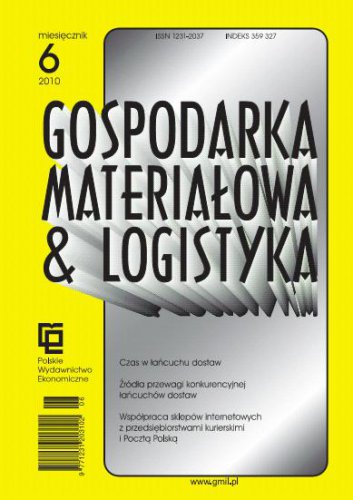Gospodarka Materiałowa i Logistyka nr 06/2010
Publication date: 2010
Place publication: Warszawa
Binding: paperback
Spis treści
Aleksandra Laskowska-Rutkowska
Czas w łańcuchu dostaw
Artykuł omawia aktualny od wielu lat problem kompresji czasu w łańcuchu dostaw. Publikacje z lat 90. wskazywały na ogromny niezagospodarowany potencjał w tym obszarze. Badania grupy PRTM z 2008 r. wskazały, że menedżerowie uczestniczący w badaniu, niezależnie od regionu, który reprezentowali, na pierwszym miejscu w swoich priorytetach na 2010 r. umieścili zwiększenie elastyczności łańcuchów dostaw. Elastyczność osiąga się poprzez redukcję czasu cyklu oraz proces dostarczania produktów na rynek w odpowiedzi na występujący popyt, czyli stosowanie mechanizmu typu pull.
O ile jednak w latach wcześniejszych koncentrowano się głównie na aspektach operacyjnych (skracanie czasu realizacji zamówienia, skracanie czasu dostaw), o tyle obecnie zauważa się zwrócenie uwagi na aspekty strategiczne (tworzenie elastycznych, szybko reagujących łańcuchów dostaw). Wskazuje to na głębsze i powszechniejsze rozumienie istoty zarządzania czynnikiem czasu w łańcuchu dostaw.
Time in supply chain
The paper discusses, quite popular since many years, idea of time compression in supply chain. The publications from the 90-ties pointed out the huge but still not utilized potential in this area. PRTM research conducted in the year 2008 revealed that by 2010, the need for greater supply chain flexibility will overtake product quality and customer service as the major driver for improving supply chain strategy. Supply chain flexibility is achieved through time compression and pull mechanism.
In the previous years the attention has mainly been given to the operational aspects of supply chain management. Nowadays the main focus are strategic issues like building flexible, quick reacting supply chains. It shows the deeper understanding of time management in supply chain.
Artur Świerczek
Źródła przewagi konkurencyjnej łańcuchów dostaw. Domena produktowo-rynkowa
Publikacja przedstawia wyzwania stojące przed współczesnymi łańcuchami dostaw w obszarze pozycjonowania organizacji w sektorze oraz dopasowania oferty produktowej do wymagań poszczególnych grup klientów. W artykule zaprezentowano podstawowe konfiguracje łańcuchów dostaw poparte omówieniem mechanizmów funkcjonowania przykładowych organizacji. W celu wyjaśnienia problematyki podejmowanej w niniejszej publikacji posłużono się założeniami szkoły pozycyjnej oraz zasobowej – podstawowych nurtów zarządzania strategicznego, wyjaśniających źródła przewagi konkurencyjnej organizacji w sektorze.
The sources of competitive advantage of supply chains. The product and market domain
The paper presents the challenges of contemporary supply chains in terms of organization’s position in industry and an alignment of product offering with customers’ needs. The basic configurations of supply chains, illustrated by characterizing the exemplary organizations, are presented in a paper. The discussion in a paper is based on the premise of industrial approach and resource based view, being the fundamental concepts in strategic management explaining the sources of competitive advantage in a market.
Grzegorz Chodak, Łukasz Latus, Ewa Prałat
Współpraca sklepów internetowych z przedsiębiorstwami kurierskimi
i Pocztą Polską – wyniki badań
W pierwszej części artykułu przedstawiono charakterystykę rynku usług pocztowych i kurierskich w Polsce, jego segmentację oraz regulacje prawne jakim podlega. W drugiej części zaprezentowano wyniki badań dotyczących jakości współpracy sklepów internetowych z przedsiębiorstwami kurierskimi i Pocztą Polską ze szczególnym uwzględnieniem najczęściej występujących problemów, wraz z obszernym komentarzem autorów.
Analysis of cooperation of the internet shops with courier services and Polish Post - survey results
The first part of this article presents characteristics of the market of postal and courier services in Poland, its segmentation and regulations to which they are subject to. The following chapter introduces results of the research concerning the quality of cooperation of the online shops with postal and courier services in Poland. The focus of this part is on the most frequent problems and vast commentary of the authors.
E-biznes
Marcin Rychwalski
System informowania kierownictwa MIS w organizacji
W artykule przedstawiono projekt wdrożonego systemu informowania kierownictwa MIS (ang. Management Information System) w organizacji, która prowadzi działalność muzealno-wystawienniczą, związaną ze sprzedażą dużej liczby biletów, a także materiałów informacyjnych. Koncepcja systemów informowania kierownictwa powstała w latach 60. XX w., głównie dzięki rozwojowi baz danych oraz przetwarzania w czasie rzeczywistym. Systemy te pozwalają na bieżące planowanie i kontrolę procesów zachodzących w przedsiębiorstwie, np. produkcji lub sprzedaży. Zadaniem systemu jest ułatwienie podejmowania decyzji dzięki dostarczaniu szerokiego spektrum informacji o procesach zachodzących w przedsiębiorstwie. Za jego pomocą, wykorzystując dobrze strukturalizowane dane pochodzące z systemu transakcyjnego, w zależności od potrzeb można dokonywać analizy działalności, oceny historii współpracy z kontrahentami lub dostawcami, a także ewidencjonowania przebiegu wykonania poleceń służbowych.
Management Information System Project in a company
The article presents the project of Management Information System implementation in an organization involved in museum and exposition activity connected with selling large quantities of entrance tickets and also information brochures. The conditions of setting up the project, as well as its planning and implementing processes have been discussed. The system solved information flow problems of the simultaneously conducted development project, and also created decision basis for the organization’s management. The conception of MIS came into being in the 60’s, mainly thanks to the rapid development of databases and the real time data processing. These systems make current enterprise planning and processes setting control possible, e.g. in production or sales. The main task of the system is facilitation of decision-making through delivering a wide spectrum of information on processes taking place in a company. It helps to analyze the company performance and the history of its cooperation with suppliers and other business partners. It also allows to register business recommendations status, based on the well-structured data from MIS.
| Odbiór osobisty | 0 € |
| Kurier Inpost | 4 € |
| Kurier FedEX | 4 € |
| Inpost Paczkomaty | 4 € |
| Free delivery in Reader's Club | from 47 € |

